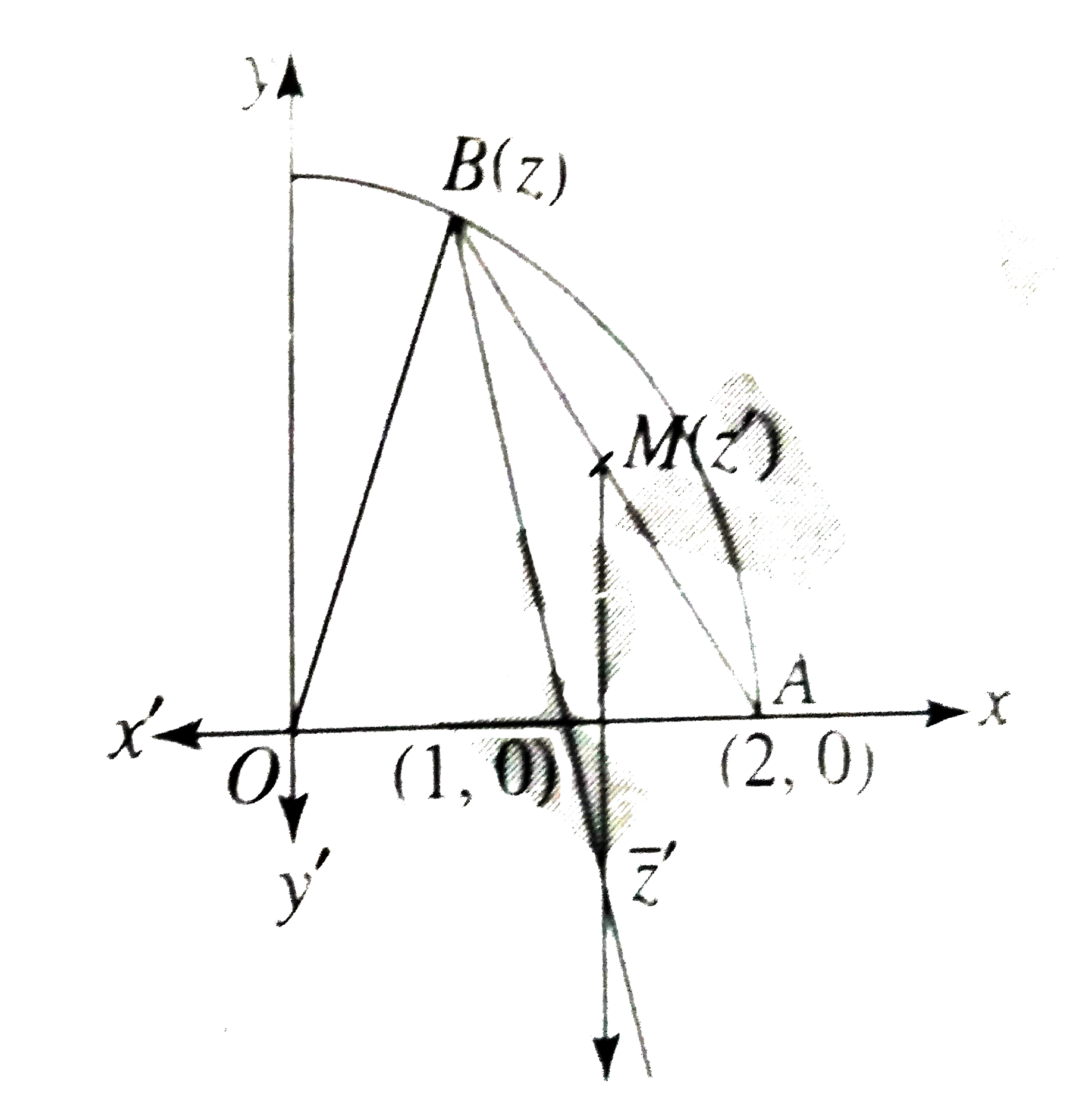If the points A(z),B(-z),C(1-z) are the vertices of an equilateral triangle ABC then Re(z) isSolution in Bengali
tan−1(√155)
tan−1(√15)
tan−1(5√15)
π2
The correct Answer is:A
(a) M(z') is mid point of AB, so z'=z+22

⇒¯z'=¯z+22
Now z, 1,¯z2+1 are collinear
⇒∣∣
∣
∣∣z¯z1¯z2+1z2+11111∣∣
∣
∣∣=0
⇒z(z2+1−1)−¯z(¯z2+1−1)+1(¯z2−z2)=0
⇒z22−(¯z)22+¯z−z2=0
⇒(z−¯z)(z+¯z−1)=0
⇒z−¯z=0 or (z+¯z−1)=0
⇒z+¯z=1 or Re(z)=12
|z|=2⇒14+(Im(z))2=4
⇒Im(z)=√152
⇒z=12+i√152
⇒arg(z')=tan−1(√155)
Topper's Solved these Questions
- COMPLEX NUMBERSBook:CENGAGE PUBLICATIONChapter:COMPLEX NUMBERSExercise:Multiple Correct Answer
Explore 11 Videos
- COMPLEX NUMBERSBook:CENGAGE PUBLICATIONChapter:COMPLEX NUMBERSExercise:Matching Column
Explore 1 Video
- CIRCLESBook:CENGAGE PUBLICATIONChapter:CIRCLESExercise:Comprehension Type
Explore 8 Videos
- CONIC SECTIONSBook:CENGAGE PUBLICATIONChapter:CONIC SECTIONSExercise:All Questions
Explore 102 Videos
Similar Questions
Complex numbers whose real and imaginary parts x and y are integers and satisfy the equation 3x2−|xy|−2y2+7=0, Find the value of x and y.
View SolutionEvaluate :
i−47
View Solution
In the diagram as shown, a circle is drawn with centre C(1,1) and radius 1 and a line L. The line L is tangent to the circle at Q. Further L meets the y-axis at R and the x-axis at P in such a way that the angle OPQ equals θ where 0<θ<π2.
Coordinate of Q is
View SolutionGiven that A(1,1) and B(2,−3) are two points and D is a point on AB produced such that AD=3AB. Find the coordinates of D.
View SolutionIf |u|=|v|=1uv!=-1 and z=(u-v)/(1+uv) then (a) |z|=1( b) Re(z)=0 (c) Im(z)=0 (d) Re(z)=Im(z)
View SolutionIf the points A(z),B(−z),andC(1−z) are the vertices of an equilateral triangle ABC, then (a)sum of possible z is 12 (b)sum of possible z is 1 (c)product of possible z is 14 (d)product of possible z is 12
View SolutionIf the points A(z),B(-z) and C(z+1) are vertices of an equilateral triangle then
View SolutionIf the vertices of an equilateral triangle are situated at z=0,z=z_(1),z=z_(2) .then which of the following is/are true
View Solutionएक समद्विबाहु समकोण त्रिभुज , जो C पर समकोण है, के शीर्ष A, B, C क्रमशः सम्मिश्र संख्याएँ z1,z2,z3 है | दिखलाइये कि (z1−z2)2=2(z1−z3)(z3−z2)
View Solutionयदि किसी समबाहु त्रिभुज के शीर्ष z1,z2,z3 हो ताकि |z1|=|z2|=|z3| तो साबित करे z1+z2+z3=0
View SolutionIf |z−3|=min{|z−1|,|z−5|}, then the values of Re(z) will be
View SolutionIf |Z−2|=2|Z−1|, then the value of Re(Z)|Z|2 is (where Z is a complex number and Re(Z) represents the real part of Z)
View SolutionIf the points A(z), B(-z) and C(1-z) are the vertices of an equilateral triangle, then value of z is
View SolutionIf the points A(z),B(−z),andC(1−z) are the vertices of an equilateral triangle ABC, then (a)sum of possible z is 12 (b)sum of possible z is 1 (c)product of possible z is 14 (d)product of possible z is 12
View Solutionनिम्न के बिंदु पथा ज्ञात कीजिएः
a. |z−1|2+|z+1|2=4 b. Re(z2)=0
View Solutionमाना A, B, C तीन सम्मिश्र संख्याऐं इस प्रकार परिभाषित है कि
A{z:|z+1|≤2+Re(z)},B={z|z−1∣≥1} और C={z:∣∣∣z−1z+1∣∣∣≥1}
क्षेत्र A∩B∩C में उन बिन्दुओं की संख्या जिनके निर्देशांक पूर्णांक है, होगी
View Solution
